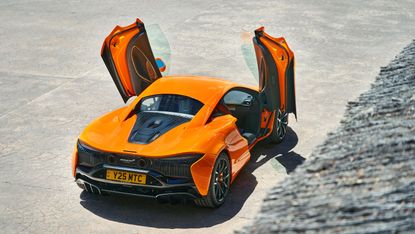New McLaren Artura is a long-awaited riposte to the supercar status quo
The McLaren Artura is all new from the ground up, designed to redefine the elements that go into making up a modern supercar
- (opens in new tab)
- (opens in new tab)
- (opens in new tab)
- Sign up to our newsletter Newsletter

McLaren has always punched above its weight. The British company is coming up on its 60th birthday, having travelled a long way from being a small racing start-up to inhabiting a huge, swooping, space-age HQ and factory complex, set in rolling woodland just outside the Surrey town of Woking. Most of this Foster and Partners-designed structure is given over to shaping, crafting and rebuilding the company’s Formula 1 cars, while a sleek separate building houses manufacturing facilities for McLaren’s road car division, which started in earnest back in 2011.

The newest machine to roll off these high-tech lines is the Artura, a hybrid V6 mid-engined supercar that bears a strong familial resemblance to McLarens past.
After a decade of making exceptional sports cars that often struggled against the unstoppable tide of high-profile competitors, buoyed by its wealth of experience and a cult-like following amongst customers and fans alike, McLaren hopes the Artura’s high-tech approach might win over a new generation of customers.

The Artura is probably the most elegant McLaren ever designed, with a simplicity of execution and an admirable sense of restraint. Yes, there are elements of blatant, outré drama, like the trademark ‘dihedral’ doors that swing up, not out, as well as a plethora of deep vents and ducts. And if you opt for signature McLaren orange paint, it's hard to argue this is an especially stealthy machine.

But there’s a certain subtlety here that’s lacking in Italian rivals. For a start, the car starts up in EV mode. The raucous, attention-seeking supercar shriek is blessedly absent until you reach a certain speed or click through to ‘Comfort’ mode.
The V6 sits behind the passenger compartment, in a carefully shaped niche within the all-new carbon and aluminium structural architecture. Crucially, this rock-solid core has space for both battery pack and engine, with bolt-on bits for crash structure and rear suspension, giving the Artura a sense of impervious unbendability.

There’s weight saving aplenty too, from the new electronics system that cuts down on cabling to an obsessive-compulsive attention to any kind of detail that might save a few grams here and there.
The end result is a car that’s under 1,500kg fully fuelled; not bad for a modern hybrid, let alone one capable of over 200mph. Visibility is excellent, front and back; steering is perfectly pitched; and the Artura's suspension can dial in a refined ride quality that makes it an excellent long-distance machine as well as a track toy.

Add these elements together – power, rigidity, lightness – and you have the classic recipe for driving entertainment. What makes the Artura all the more appealing is the way its raw ability unfolds in stages, rather than serving up 100 per cent of everything, all the time.

Although the electric range is a paltry 19 miles, the Artura is good at managing the battery charge by itself (you can also plug it in), ensuring you can flick it back into EV mode for a quieter driving experience when needed.
Of course, as a pure EV, the Artura isn’t quite a charging supercar, but a little bit of restraint goes a long way when you’re driving a car like this.

Other welcome innovations include an upgraded infotainment system and a general reshuffle of McLaren’s once-wayward cabin architecture.
Ergonomics are better, menus are snappier, graphics are cleaner, and switchgear and options have been streamlined for ease of use.
It’s distinctly possible to use a car like this as an everyday machine, even if the luggage compartment in the nose isn’t up to much.
The welcome addition of silent mobility on tap transforms the intentions and reception of a car like this; at a time when stealth wealth is overdue a comeback and the raucous sound of combustion becomes less and less socially acceptable.

It's taken slightly longer than McLaren hoped to bring the Artura to life. It’s an excellent car and a genuine alternative to Ferrari’s comparable 296 GT. However, even Ferrari now offers an SUV (opens in new tab), leaving McLaren the lone luxury brand without one. Expect that to change within the next few years, with rumours of an electric McLaren SUV circulating.
Although the Artura is a sophisticated model from a company that prides itself on technological leadership, the next generation of McLarens will represent an even greater leap forward.
McLaren Artura, from £185,735
Cars.McLaren.com (opens in new tab)
Jonathan Bell has written for Wallpaper* magazine since 1999, covering everything from architecture and transport design to books, tech and graphic design. He is now the magazine’s Transport and Technology Editor. Jonathan has written and edited 15 books, including Concept Car Design, 21st Century House, and The New Modern House. He is also the host of Wallpaper’s first podcast.
-
 ‘When We See Us’: Black figurative painting at Cape Town’s Zeitz MOCAA
‘When We See Us’: Black figurative painting at Cape Town’s Zeitz MOCAAA group show of Black figurative painting at the Zeitz Museum of Contemporary Art Africa, featuring 156 artists, explores the past and present of self-representation
By Sean O'Toole • Published
-
 Cara \ Davide is the Milanese design duo inventing a new design language on the cusp of contemporary and ancestral
Cara \ Davide is the Milanese design duo inventing a new design language on the cusp of contemporary and ancestralIn our Future Icons series, we explore ten next-generation designers who have made us sit up and take notice: here, we speak to Cara \ Davide about their design process and their cross-cultural inspirations
By Maria Cristina Didero • Published
-
 34th São Paulo Bienal arrives at Luma Arles for first European presentation
34th São Paulo Bienal arrives at Luma Arles for first European presentationAn exhibition of highlights from the 34th São Paulo Bienal is at Luma Arles, marking its European and tour finale
By Martha Elliott • Published


